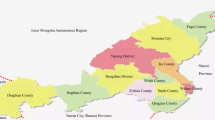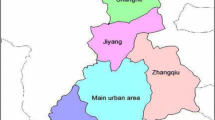Abstract
The reforming and opening-up has brought about the rapid development of China’s economy, greatly improved the living standards of rural residents, and also caused the destruction of the rural ecological environment. Due to the backward production technology and pollution control technology, many township enterprises discharge excessive pollutants, and excessive application of chemical fertilizers and pesticides in agricultural production causes serious agricultural non-point source pollution. These pollution sources that cannot be effectively controlled cause a large number of water and land resource function decline. Not only the loss of agricultural production, but they also bring hidden danger to the survival of many rural residents. Taking Xinxiang city of Hunan province as an example, this paper selects 28 indicators and mainly uses AHP, entropy weight method, and fuzzy comprehensive evaluation method to evaluate and analyze the development level of rural ecological environment. This study can provide a reference for the Chinese government to formulate rural development planning and can also be used as a reference for the evaluation of rural ecological environment in developed and underdeveloped areas.
Graphical Abstract




Similar content being viewed by others
Availability of data and materials
The data and materials used in this paper come from four aspects: (1) published journal papers and newspapers published by the government; (2) statistical information published by government departments; (3) interview survey of our research group.
Notes
The 5-year plan for the development of China’s national economy began in 1953, and 1978 was the first year of the “sixth 5-year plan.”.
References
Chen, M. (2019). Reflections on the practical characteristics and problems of rural domestic waste management-based on the investigation of 4 villages in 1 town of Hunan. Regional Governance, 46, 156–160.
Chen, X. M., Wang, C. L., & Bo, R. (2016). Present situation and countermeasures of pesticide use in China. Pesticide Science and Management, 37(2), 4–8.
Cao, H. Q. (2020). Analysis of the current situation and problems of rural domestic waste disposal. Shanxi Chemical Industry, 3, 209–210.
Dong, S. Y., Yang, X., Wang, X. L., Feng, Z. K., & Jia, W. J. (2013). Evaluation of ecological environment quality in Yongding River Basin. Population, Resources and Environment in China, 12, 348–351.
Dai, X. F., Qian, Z. B., Chen, C., & Xu, S. (2017). Comprehensive comparison of eco-environmental quality of typical counties in southern and Northern Anhui province. Journal of Biology, 34(3), 105–107.
Du, Y., Yang, W., Ding, X. Y., Zhang, J. J., Zheng, Z. M., & Zhu, J. Y. (2020). High heterogeneity of bacterioplankton community shaped by spatially structured environmental factors in West lake, a typical urban lake in Eastern China. Environmental Science and Pollution Research. https://doi.org/10.1007/s11356-020-08818-w
Ebenstein, A. (2012). The consequences of industrialization: Evidence from water pollution and digestive cancers in China. Review of Economics and Statistics, 94(1), 186–201.
Fan, X. P., Chen, S., & Zhang, J. S. (2012). Application of improved osculating value method based on entropy weight in comprehensive evaluation of water quality. Environmental Protection and Circular Economy, 4, 42–45.
Fu, W. F., Jiang, H., & Fang, J. J. (2018). Analysis of farmers’ willingness to participate in rural water pollution control and its influencing factors. Journal of Nanjing Agricultural University, 18(4), 119–126.
Guo, J. H., Liu, X. J., Zhang, Y., et al. (2010). Significant acidification in major Chinese croplands. Science, 327(5968), 1008–1010.
Guo K. Y., Feng, S. J. (2010). Current situation and control countermeasures of agricultural non-point source pollution in Puyang city. China Agricultural Technology Extension Issue 10, 26(10), 48–49.
GE, Y. H., Zhang, G. Z., Shen, L. K., et al. (2018). Investigation and analysis of rural domestic waste disposal status and farmers’ environmental awareness in Danjiangkou water conservation area. China Biogas, 36(6), 94–102.
Hu, Y., Peng, J., Liu, Y., & Tian, L. (2018). Integrating ecosystem services trade-offs with paddy land-to-dry land decisions: A scenario approach in Erhai Lake Basin, southwest China. Science of the Total Environment, 625, 849–860.
Huang, Y. Z., Han, B., Pan, C., et al. (2020). Application of a new type of stable controlled pyrolysis furnace for treating rural domestic waste. Environmental Science and Technology, 33(1), 41–44.
Jin, S. Q., Zhou, F., & Shen, G. Y. (2015). Analysis of chemical fertilizer reduction path under the dual goal of agricultural development and non-point source pollution control. Environmental Protection, 8, 50–53.
Kong, X. Z., Qiang Gao, Q. (2017). The change of rural collective economy in China since the reform and opening-up and the urgent problems to solved Theoretical Exploration, 1. https://doi.org/10.3969/j.issn.1004-4175.2017.01.019
Liang, L. T., Li, B., & Duan, H. J. (2015). Evaluation of coordination between rural development and ecological environment and analysis of its spatiotemporal differentiation characteristics. Journal of Henan University, 45(3), 320–326.
Liu, Y. (2016). Management measures and implications for municipal sewage treatment in Sweden. Environmental Pollution and Prevention, 38(2), 81–85.
Long, A. L. (2017). Problems and countermeasures of sewage treatment in small towns. Low Carbon World, 11, 1–2.
Li, Y. (2017). Technical analysis of rural domestic sewage treatment. Resource Information and Engineering, 32(1), 175–176.
Liang, H. L., & Huanli Zheng, H. L. (2020). Agricultural non-point source pollution control in Fuxian Lake runoff area. Yunnan Agriculture, 6, 43–46.
Li, L., Jing, X. L., Wang, L., Zeng, Z. G., Chen, W. H., Zhai, J. H., & Qi, S. Q. (2020). The extract of aquatic macrophyte Carex cinerascens induced colony formation in bloom-forming cyanobacterium Microcystis aeruginosa. Environmental Science and Pollution Research. https://doi.org/10.1007/s11356-020-08651-1
Long, S. X., Zhang, T., Fan, J. J., Li, C., Xiong, K. N. (2020). Responses of phytoplankton functional groups to environmental factors in the Pearl River, South China. Environmental Science and Pollution Research, https://doi.org/10.1007/s11356-020-08344-9
Liu, Y., Zhai, X. L., & Zhou, M. L. (2020). Farmers’ cognition of the value of agricultural film recycling and its influencing factors. Journal of Arid Land Resources and Environment, 34(2), 80–86.
Peng, W. J. (2019). Study on the optimization of rural domestic waste classification policy. Economic Research Guide, 34, 21–23.
Qi, C., Fang, J. Q., Wang, G. X., Huang, H. X., Wang, Z. S., Si, Z. J., & Zhang, L. M. (2020). Characterization of odorants in contrasting ecotypes of Lake Taihu: Algae-dominated versus macrophyte-dominated zones. Environmental Science and Pollution Research. https://doi.org/10.1007/s11356-020-07896-0
Riccardo, R., Massimiliano, G., & Gregorio, G. (2013). Comparison of fuzzy-based and AHP methods in sustainability evaluation: A case of traffic pollution-reducing policies. European Transport Research Review, 5(1), 11–26.
Tian, Y. Q., Gao, L., Deng, J. M., & Li, M. (2019). Characterization of phytoplankton community in a river ecosystem using pigment composition: A feasibility study. Environmental Science and Pollution Research. https://doi.org/10.1007/s11356-019-07213-4
Wen, B., Liu, Y. Z., Xia, M., & Wang, W. (2016). Evaluated the suitability of rural residential land layout from the perspective of ecological environment protection-taking Yixing city of Jiangsu province as an example. Bulletin of Soil and Water Conservation, 36(4), 280–285.
Wu, D. B., & Li, B. (2019). A preliminary study on the classification treatment model of rural domestic waste in northern Anhui province-taking the pilot project of rural garbage classification in Qiaocheng district of Bozhou city as an example. Intelligent City, 13, 140–140.
Wagale, M., & Singh, A. P. (2019). The application of adaptive neuro-fuzzy inference system and fuzzy Delphi technique to assess socio-economic impacts of construction of rural roads. Transport and Telecommunication Journal, 20(4), 325–345.
Wang, M. G., & Yang, H. Q. (2020). Dilemma analysis and legal countermeasures of rural domestic waste disposal. Manager Journal, 1, 100–101.
Yang, H., Hou, R., & Song, L. (2014). Investigation and control countermeasures of drinking water sanitation in rural areas of Qingdao. Chinese Journal of Health Supervision, 21(4), 352–356.
Yang, H., Lu, Y., & Wang, L. (2019). Analysis on the status and problems of classification and utilization of rural domestic waste. Environmental Sanitation Engineering, 27(6), 64–67.
Zeng, Y. S. (2018). Present situation and coping strategies of rural domestic sewage treatment. Resource Saving and Environmental Protection, 5, 99–100.
Zhang, C., Yunguan Xi, Y. G., & Xiao, X. J. (2018a). Organic agriculture promotes green development and non-point source pollution prevention and control. World Environment, 4, 36–39.
Zhang, J. Q., Duan, W. W., & Zhu, Y. B. (2018b). Comprehensive evaluation of habitat environment in rural poor areas of Western Hunan. Enterprise Economy, 9, 176–181.
Funding
The funds used in this study are derived from government projects and do not accept any funding from enterprises or individuals. This work is partially supported by Key project of national social science fund (No. 18AGL001); Natural Science Project of Colleges and Universities in Jiangsu province (19KJB550009).
Author information
Authors and Affiliations
Contributions
This research topic and the research framework are proposed by Wei Xu. Fen Xu has completed the preliminary data collection and is responsible for organizing and arranging the students’ field survey. Yunzhe Liu and Dan Zhang are graduate students. They are responsible for leading other students to conduct field research. Wei Xu finished his thesis.
Corresponding author
Ethics declarations
Ethics approval
Not applicable.
Consent to participate
Not applicable.
Consent for publication
If this article can be accepted for publication, all authors agree.
Competing interests
The authors declare no competing interests.
Additional information
Publisher's Note
Springer Nature remains neutral with regard to jurisdictional claims in published maps and institutional affiliations.
Highlights
• The main problems of ecological environment in rural areas of China are analyzed.
• The evaluation index system of rural ecological environment in China’s moderately developed areas is constructed, which is composed of four first level indicators and 28 s level indicators.
• The ecological environment of Xinxiang city in Henan province was evaluated vertically and horizontally by using fine model and fuzzy comprehensive evaluation method.
• This paper analyzes and summarizes the current situation of ecological environment development and the main influencing factors of slow development in Xinxiang city.
Rights and permissions
About this article
Cite this article
Xu, W., Xu, F., Liu, Y. et al. Assessment of rural ecological environment development in China’s moderately developed areas: a case study of Xinxiang, Henan province. Environ Monit Assess 193, 801 (2021). https://doi.org/10.1007/s10661-021-09383-6
Received:
Accepted:
Published:
DOI: https://doi.org/10.1007/s10661-021-09383-6




